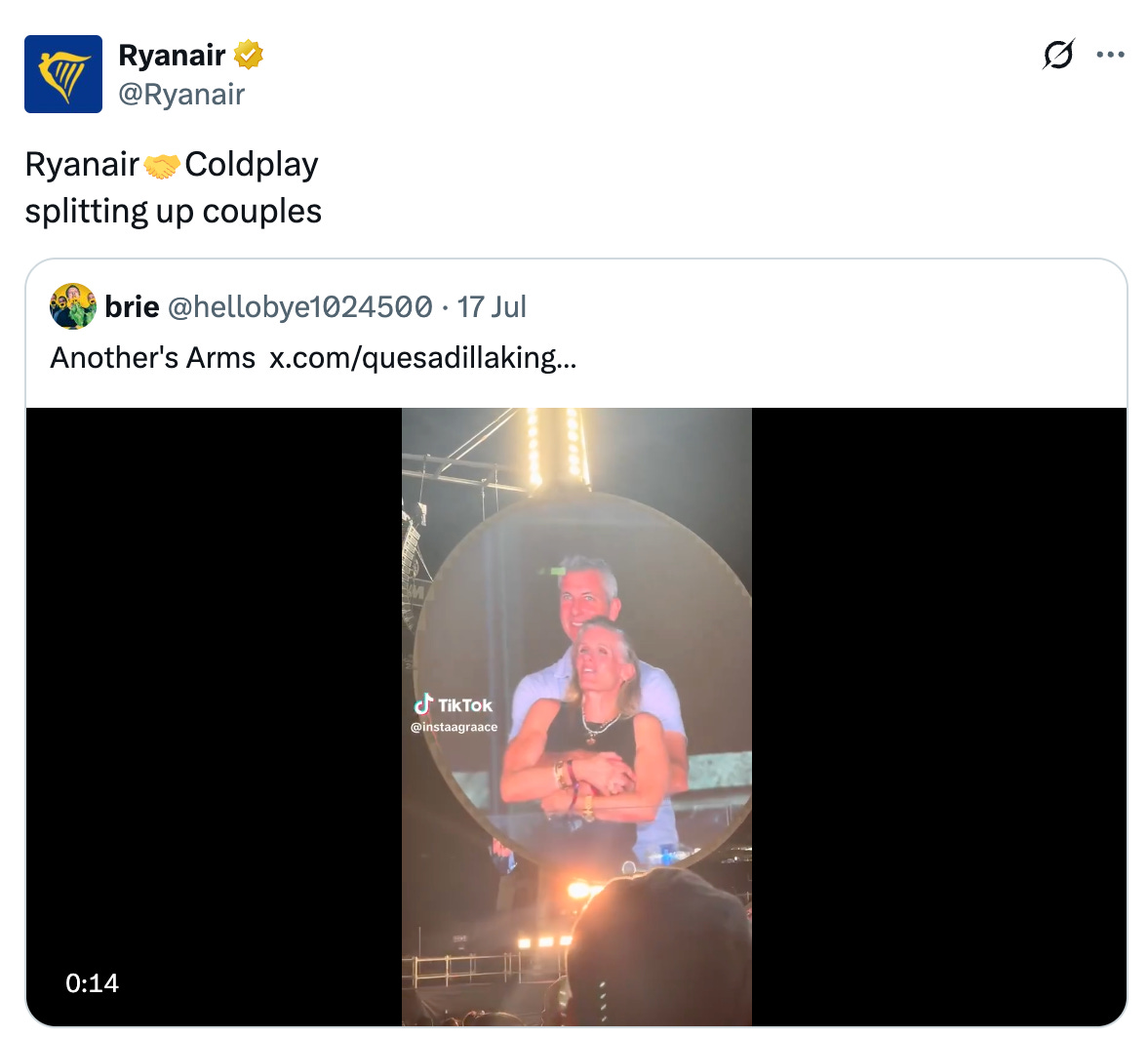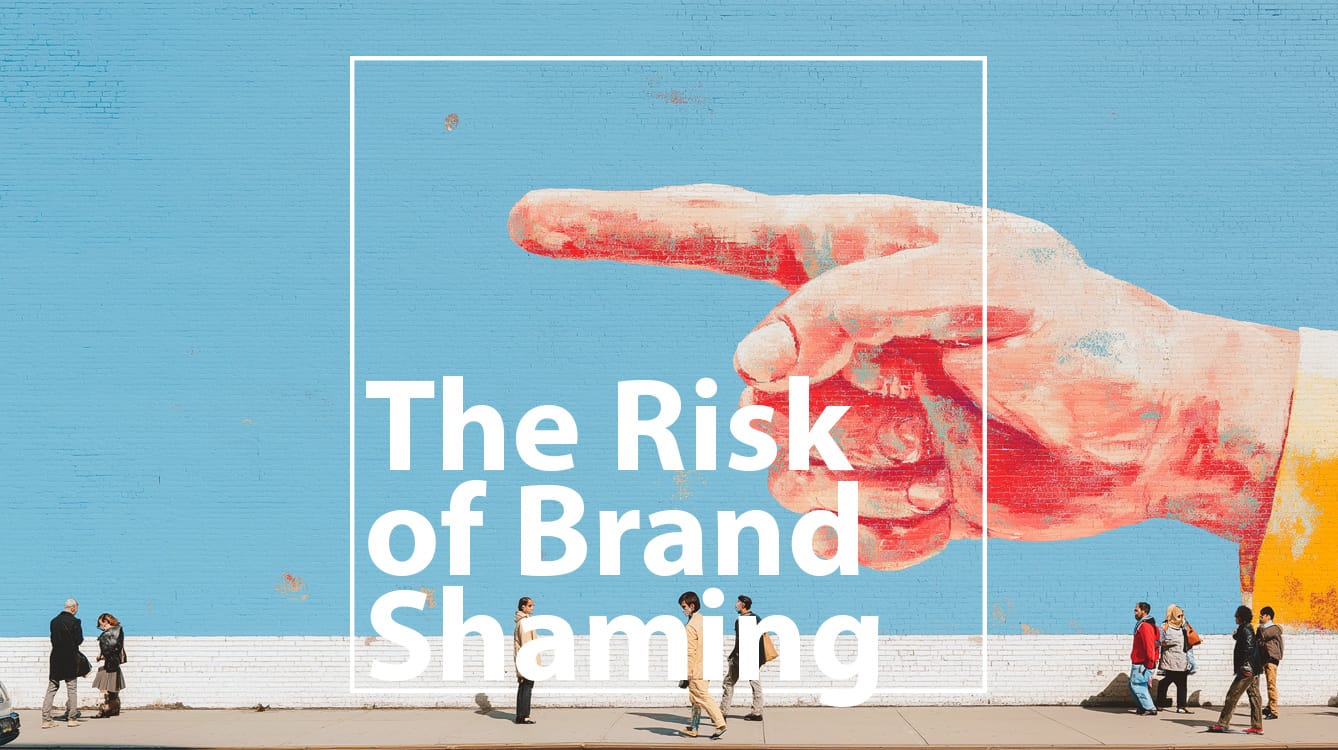The viral ‘Coldplaygate’ kiss cam moment that exposed Astronomer executives has become a class in how brands can exploit human humiliation for marketing gain. While companies rushed to capitalize on the scandal with clever content, this phenomenon also represents a troubling moment in marketing and cultural ethics – where brands should ask if they ‘should’, not just if they ‘can’. The risk in playing it wrong is shared by brands, culture and the people targeted.
What is ‘Coldplaygate’?
On July 15 2025, during a Coldplay concert at Gillette Stadium, Astronomer CEO Andy Byron and the company’s Head of HR, Kristin Cabot, were featured on the stadium’s “kiss cam.” Their visibly awkward reaction—attempting to hide and move away—was commented on by Coldplay frontman Chris Martin’s who said: “Either they’re having an affair or they’re just very shy”.
Little did he know how right he was, as this moment of personal shame escalated into a global internet phenomenon. Within hours, the footage was online, and within a day, internet sleuths had identified both individuals, their professional roles and more. The discourse rapidly included not just memes, but deepfakes, a widely circulated, but fake, apology statement attributed to Byron and an influencer posing as the CEO’s non-existent daughter.
The consequences for the individuals involved and their company were swift, as Andy Byron has resigned as CEO of Astronomer, following a formal investigation by the company’s board. While Byron resigned, Astronomer’s silence regarding Kristin Cabot’s employment status further fueled public criticism. The indirect personal toll has also been significant: Byron’s wife removed his last name from her LinkedIn profile, and both individuals’ private lives, including their marital statuses and family details, became painfully public.
From Marketing to Moral Profiteering
The speed with which people and brands commented and amplified the incident exposes what Monica Lewinsky previously identified as a culture where “shame is a commodity, and public humiliation an industry”. While the actions of the couple aren’t justifiable, moral outrage has translated into a defined ‘compassion gap’ within social media that turns people into meme fodder. As John Ronson’s book ‘So You’ve Been Publicly Shamed’ shows, online shaming destroys lives and leaves an extreme impact on those it targets.


While humans are uniquely programmed for a response to moral outrage, especially around sexual betrayal, brands were equally adept at responding – with Tesla, Netflix, NYC Sanitation, StubHub, X, Ryanair and others quickly creating content around the moment. While each brand undoubtably captured attention with their content, they also turned people, their misdeeds and their families into marketing opportunities. Waves of Etsy products from opportunistic people seem uncomfortably craven, but is it different when it comes from a brand? When public humiliation becomes marketing, are we always trading human dignity for attention?
Is It Ever Ok to ‘Punch Down’?
Brands may reflect the tendencies of the people that run them, but their scale and resources naturally mean focusing on an individual or group is ‘punching down’. This disparity in resource and platform isn’t just unfair to the subject, its a risk for brands.
As seen in previous ‘punching down’ episodes, like 2022’s “West Elm Caleb” in which a serial dater and ghoster in NYC who worked at furniture store ‘West Elm’ was vilified and ultimately doxxed, narratives can change and turn on brands over time. While Hellmann’s, Ruggable, Grubhub and others had fun at Caleb’s expense, their content ties them to a cultural moment that may go too far. As a dogpile grows, what starts as a joke can very quickly tie a brand to cyber-bullying. Brands are often held to different standards than people, which may create extra attention at involvement, but also extra risk on any blowback.
Beyond the commercial and brand risk, ethical considerations are prominent when brands focus on people in cultural moments. A brand’s activity can amplify a scandal, giving a platform for more outrage and increasingly, more disinformation. The resources normally used to capture attention can be personally weaponized and turn people into unwilling assets. As ‘anyone can go viral’ in today’s society (for right or wrong reasons), brands risk being seen as craven opportunists, and potentially threats, when they misuse their platform.
Brands Can Punch In Other Directions
So is it ever ok to ‘punch down’? For brands it takes a unique brand strategy and guidelines, as well as a nuance in approach. Brands roasting users in social media, like Ryanair, Tesco Mobile, Cards Against Humanity and Wendy’s have done, cuts a different tact than joining in on a cultural dog pile. People are arguably ‘in on the joke’ and with these interactions, an appetite for engagement often comes from users speaking to the brand. Additionally, brands can still be spiky to groups, as Brewdog and others have done.
Brands find a more equal opponent focusing on other brands. ‘Punching Up’ against categories and competitors makes a brand the challenger, fighting for customers not against them. As a common part of a marketers playbook, often referenced as using a brand’s wide resources for change, challenger brands underscore the disproportionate nature of turning content against potential customers themselves.
Overall, people and brands in modern social media are competing for attention, but marketers are best suited to avoid base instincts for outrage and cultural dogpiles when trying to get noticed. Despite being a common part of society from Hawthorne to Hulu, the short term attention gains may not be worth long term brand and ethical risks.





